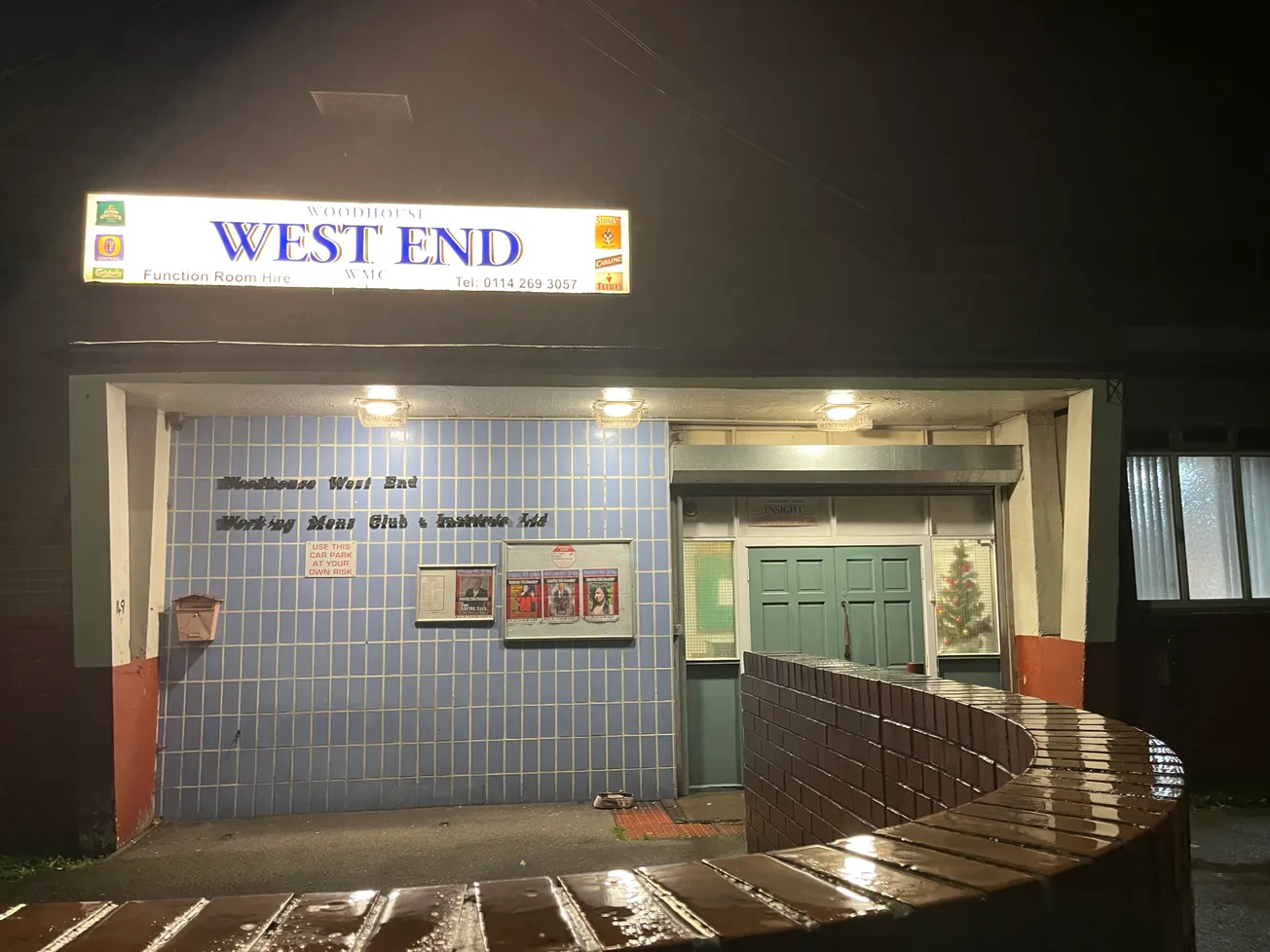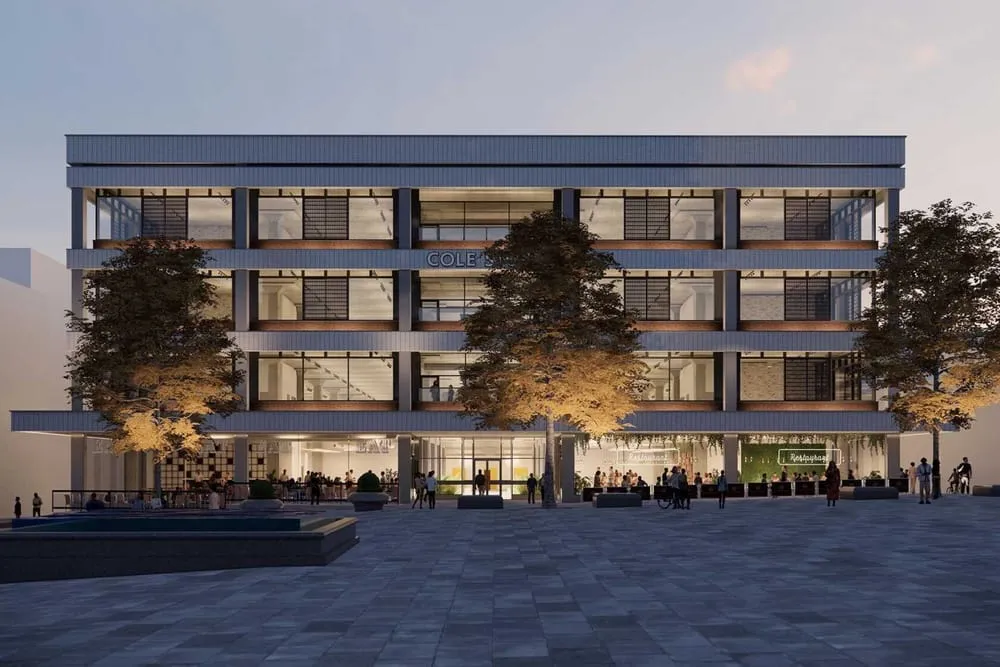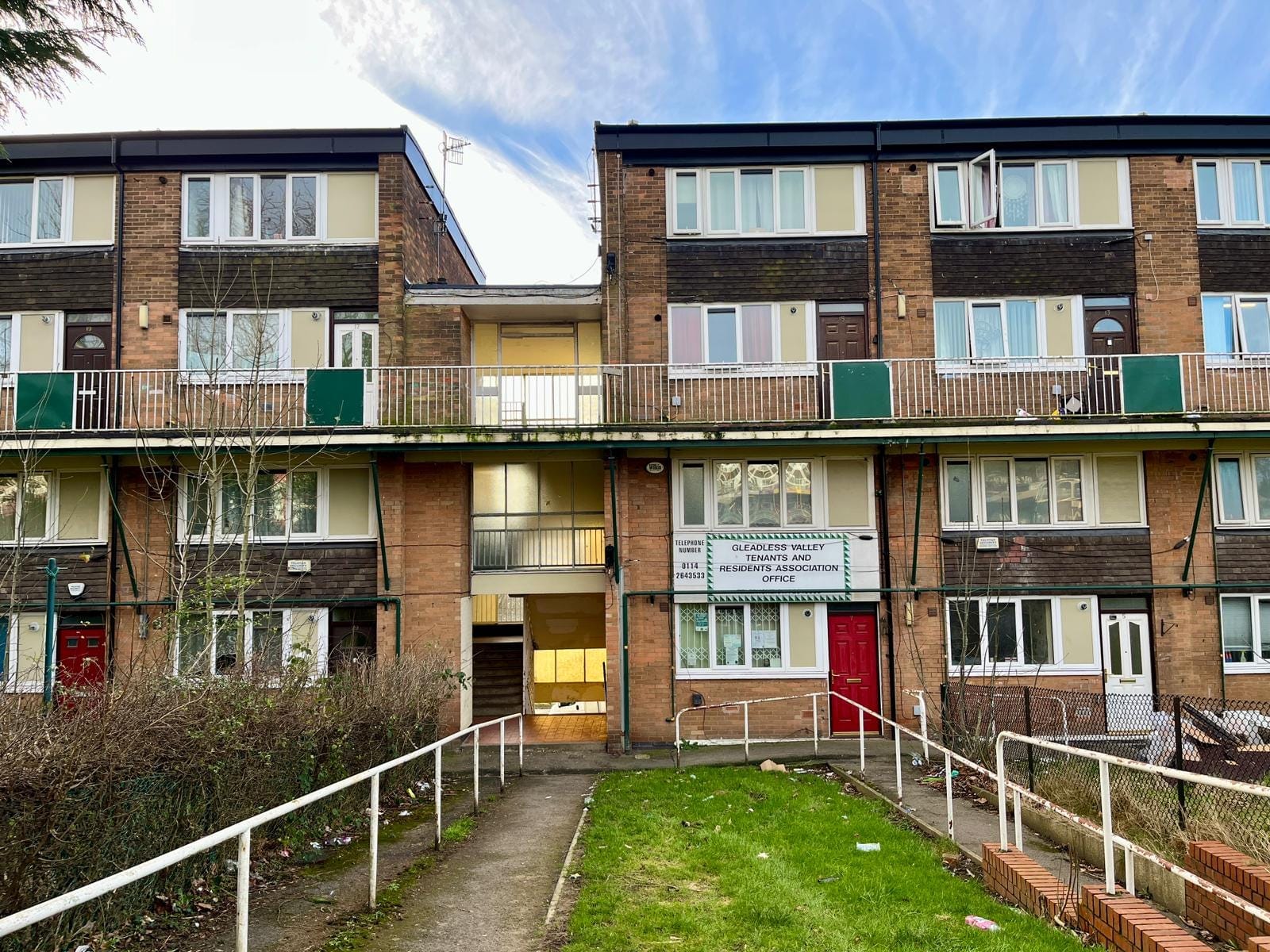“Anyone know when the flats around Gleadless are getting knocked down,” a message on Facebook asked earlier this week. “Which ones,” came the reply. “Hopefully mine with any luck,” shot back the original poster. It’s the kind of exchange that happens billions of times online everyday. But at the moment in the Gleadless Valley, it’s more difficult to answer than “when is bin day”.
It’s a thought that many others on the estate are having too. As I head into the stairwell at Plowright Close, a young woman is navigating the stairs with a crutch tucked into the crook of one arm. Trying to help, her partner sheepishly holds out her other crutch, ready for when she reaches the bottom.
As we get talking, the couple tell me they’ve only been here since October, but have already asked the council for a new place better suited to her needs. She has rheumatoid arthritis, making having to climb the steps of the three storey building incredibly difficult for her. When I ask them how they find living here, they laugh with a degree of embarrassment, like they don’t want to tell me what they really think. Why, what’s wrong with it? “It’s just Gleadless Valley isn’t it?”

They’ve got a point. In this city, the Gleadless Valley’s reputation means it would probably top many Sheffielders’ lists of places they’d least want to live. However, while the area might look impoverished, it’s actually meant to be in the black to the tune of £100 million. In 2017, residents were promised a regeneration scheme would transform their area with new and refurbished homes and improved facilities. If you tell people that round here you’ll get short shrift though. After seven years, why are they still waiting?
This isn’t my first time on Plowright Close. The last time I was here to write about the estate’s 60th birthday in 2022, there was a stench from a burst sewage pipe which had lain unrepaired for weeks. This time the sewage is thankfully absent and the stairwell we’re in actually smells nice, fragrant even. The maisonettes have obviously seen better days, with flaking paint on the railings, graffiti and broken windows. But it’s also clear that a lot of work goes into maintaining them. Sunshine streams in through a huge window which frames the beautiful valley beyond.
After the couple slowly make their way slowly down the street, a woman walks through the maisonettes on her way to Newfield Green shops over the road. It turns out she lives on the next block down, and says problems with her building’s plumbing means leaks happen on a regular basis. “They’re all fucked — they need knocking down,” she tells me, whispering the expletive so as not to cause offence. Have you heard of the Gleadless Valley Masterplan, I ask her. “We’ve heard lots about it but we don’t know exactly what’s happening or when,” she says. “This block is meant to be getting all pretty, but I don’t know about mine.”

The Gleadless Valley Masterplan is a £100 million council investment in the south east Sheffield estate which Sheffield City Council said would see “improvements made to housing, green spaces and facilities as well as increased employment opportunities”. The biggest investment in the estate in its 60-year history would have seen 109 new houses and apartments built, while some blocks would be remodelled and others refurbished. New green spaces and play areas were also to be built, and according to the press release, there was also going to be investment in shop fronts and community facilities. Finally, there was to be help for residents and businesses with job opportunities, apprenticeships and training.
The plan was first talked about in 2017. A public consultation then took place in 2018 and the full masterplan was published in 2022. At that time there were high hopes that the long-awaited investment might finally be about to arrive. But at the last meeting of Sheffield City Council’s housing committee in December, chair Douglas Johnson had some bad news. He said that while some work on the estate was due to start this year, skyrocketing inflation had meant the council needed to “rethink” how the masterplan would be delivered.
“The £98 million set aside for the Gleadless Valley scheme doesn't go as far as when the plan was first agreed,” Councillor Johnson told the committee meeting. In other words, inflation means that once-huge figure is significantly less so nowadays. “We can’t give dates for the start of work, never mind the finish dates.” They’re planning to have a rethink: what is a priority, what can they no longer afford. A trip back to the drawing board probably won’t be welcomed by the people of Gleadless Valley, who have suffered more than enough delays. Unfortunately, it might not be avoidable.

Built between 1955 and 1966, the Gleadless Valley estate was once the envy of the city. The range of housing types on offer, the pastoral setting and the stunning views over Sheffield made it one of the most sought-after addresses in the city. Speak to anyone who remembers when the estate was first built and they’ll proudly tell you about the 15-year waiting lists to get a house there. A piece in The Times from 1969 quoted in social housing historian John Boughton’s A History of Council Housing in 100 Estates says Gleadless Valley seemed to have been “touched by the English genius for country things”. In his Municipal Dreams blog, Boughton quotes former president Royal Institute of British Architects Lionel Esher as saying the estate was “one of the prettiest suburbs in England and undoubtedly a powerful agent in the embourgeoisement of the Yorkshire working man — whatever one may think of that”.
But the 60s and 70s heyday wasn't to last. Industrial decline in the 80s saw the estate struggle with the problems of mass unemployment and everything that came along with it: health problems, drug and alcohol abuse, and crime. The area had barely recovered from the economic shock by the time austerity began in 2010. In recent years, “the Valley” as everyone calls it has become known in Sheffield as a “sink estate”. A quick Google finds a piece in The Star naming a street in the area as the third worst in Sheffield for burglaries, another in Yorkshire Live describing it as a “no go zone of crime", and a BBC story in which residents complain about “uninhabitable” properties.
Walking around the Gleadless Valley in the bright January sunshine this week, the area seems to me like a typical council estate. Not without its problems, sure, but hardly a “no go area”. Several groups of teenagers walk past me trailing plumes of cannabis smoke behind them. Drinking in public doesn’t seem to carry the social stigma it does in other parts of the city. Around half of the dogs I meet seem to be Bully XLs. But the people I speak to are friendly and happy to speak to an outsider about the problems of their area.

Another thing which strikes me is the sheer number of Sheffield City Council repair vans here. I see well over a dozen in just a few hours, indicating that many of the properties are in states of disrepair. One workman tells me many of the houses were only built to last 30 years and have now been around more than double that. The main problems affecting the properties are broken windows and damp, he adds.
Most people I speak to have heard of the masterplan, but the continual delays have caused understandable confusion and mistrust. The woman I speak to on Plowright Close tells me she has heard that those maisonettes are being done because they can be seen from the road, while other blocks are being left as they are more hidden. There’s no evidence that this is the basis on which decisions have been made but in an information vacuum, conspiracy theories like this tend to grow. Another resident tells me the latest she heard was that her block won’t get done until 2028.
At The Blackstock pub over the road, landlady Debra seems to know more than most, but even she has reached the point where doubts have begun to creep in. “Every six months people come round and say these are the plans but then you don’t hear anything,” she tells me. “You just get disheartened because nothing happens.” Debra has worked at The Blackstock for 23 years, and has been the landlady for the last four. She understands inflation is the reason behind the latest delays, but says she doesn’t know why they can't at least start some of it. The need for investment in the area is so acute that it can’t wait another few years, she adds. As I leave I tell Debra I’ll let her know If I find out any more from the council. “Don’t hold your breath,” she says.

At December's meeting of the housing committee, Councillor Johnson did reveal that some work would be getting underway this year. This includes demolishing two former care home sites to allow for new housing to be built on them in the future, and a multi-use games area or MUGA on land near Holy Cross Church on Spotswood Mount. Outside Holy Cross Church another council repair worker I meet seems surprised when I tell him about the MUGA. “I’d be amazed if that happens,” he says. “They’ve been talking about regenerating this area for years and they will still be talking about it years from now.”
Nearby residents aren’t any better informed either. Two women who live in a house backing onto the area in question have heard of the masterplan but look at me blankly when I ask about the MUGA. And a man walking back from the Happy Shopper is equally surprised. He tells me facilities for kids aren’t great in the area. “We’ve got a 14-foot swimming pool which we set up in the summer,” he says. “But the council told us it’s a health and safety hazard.”
On the other side of the valley it’s a similar story. The southern portion of the valley is known locally as the “posher side”, but the masterplan extends here too. The former site of Hemsworth Junior and Infant School has been earmarked for a play area and older people’s accommodation, although that seems to be news to the people walking their dogs on it on Wednesday morning.

One woman walking a boisterous Staffy on the waste ground tells me the school was knocked down in 2004 and since then has just been left. “Nobody seems to know what’s happening,” she says. “This area does need something for kids to do rather than playing on the computer all the time though.” As it turns out she went to the school we’re now walking in the remnants of and now has grandchildren who live on the estate. “I grew up here and it was a great place to live,” she says. “There’s not that much left here for kids today.”
And at the Gaunt shopping centre further down the hill, Lee Hartley from A. E. Hartley & Son grocers is aware that they are meant to be doing “something for the kids” where the school used to be, but other than that he’s in the dark about the council's plans. “If you do find something out please come and tell us because we don’t know,” he says. “The last thing we heard it was going to be years. The council always promises a lot and nothing gets done.”
Alexi Dimond, Green councillor for Gleadless Valley ward, acknowledged the delays had caused scepticism in the area. However, he said that inflation caused by Covid, the war in Ukraine, and Liz Truss’s mini-budget had meant that the total costs of the masterplan had nearly doubled from around £90 million to £160 million. This increase has meant that the council has had to “reevaluate what it can do and in what order,” he added, with one proposed new housing development on Gaunt Road already having been shelved as it is too expensive.

In terms of things that are happening, Councillor Dimond said that the green spaces and play areas at Spotswood and Hemsworth should be getting underway soon, as will the multi-use games area. There has also been talk of giving the food bank and food cooperative Regather new bases at Gaunt Road shops. “I wouldn't say we’re back to the drawing board,” he tells me. “There are positive things happening but the housing side is very frustrating.”
A spokesperson for Sheffield City Council told The Tribune that the housing department was currently working with quantity surveyors to review the construction costs for various capital elements of the project, and to commence a draft phased delivery plan that will be the subject of resident consultation. “It is hoped there will be a clearer understanding of costs, timelines for delivery and delivery options during the summer of this year,” they added. “With selected new-build development, refurbishment and demolition work due to commence in Spring 2025, subject to resident and Council approval.”
When the investment finally does come, it will undoubtedly be welcome. But whether it will solve all the area’s problems, I’m less sure. Poor housing and a lack of amenities are factors in Gleadless Valley’s current condition. Perhaps just as important to consider are the lack of jobs and money in the area. While many of the council properties have been sold off under right to buy, more than 50% of them are still owned by the authority. But rather than the original universal vision of housing for all, over the last 50 years, social housing has increasingly become a housing of last resort, meaning that poverty becomes entrenched in places like the Gleadless Valley.

Opposite the Gaunt shopping precinct is the area’s methodist church on Blackstock Road, where the area’s foodbank is run from. Manager Jock tells me the service was first set up in 2011, and catered for about six families at first. Now they regularly see up to 50 families a week, with many of their clients in work but still not making enough money to make ends meet.
Ultimately, without action to address this endemic poverty, the area will inevitably get worse, he tells me. Lots of children here have never even left the Gleadless Valley, he says. In the absence of hope, it’s all too easy for them to be groomed into a life of crime by the area’s drug dealers. “I can’t tell you anything about the masterplan, but I can tell you what this estate needs,” he says. “It needs the council to stop using it as a dumping ground.”
What do you think of the Gleadless Valley Masterplan and the delays it has suffered? As always, paying members can let us know what they think in the comments section.
Comments
How to comment:
If you are already a member,
click here to sign in
and leave a comment.
If you aren't a member,
sign up here
to be able to leave a comment.
To add your photo, click here to create a profile on Gravatar.







